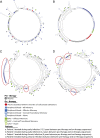The HIV-1 reservoir in eight patients on long-term suppressive antiretroviral therapy is stable with few genetic changes over time
- PMID: 24277811
- PMCID: PMC3870728
- DOI: 10.1073/pnas.1308313110
The HIV-1 reservoir in eight patients on long-term suppressive antiretroviral therapy is stable with few genetic changes over time
Abstract
The source and dynamics of persistent HIV-1 during long-term combinational antiretroviral therapy (cART) are critical to understanding the barriers to curing HIV-1 infection. To address this issue, we isolated and genetically characterized HIV-1 DNA from naïve and memory T cells from peripheral blood and gut-associated lymphoid tissue (GALT) from eight patients after 4-12 y of suppressive cART. Our detailed analysis of these eight patients indicates that persistent HIV-1 in peripheral blood and GALT is found primarily in memory CD4(+) T cells [CD45RO(+)/CD27((+/-))]. The HIV-1 infection frequency of CD4(+) T cells from peripheral blood and GALT was higher in patients who initiated treatment during chronic compared with acute/early infection, indicating that early initiation of therapy results in lower HIV-1 reservoir size in blood and gut. Phylogenetic analysis revealed an HIV-1 genetic change between RNA sequences isolated before initiation of cART and intracellular HIV-1 sequences from the T-cell subsets after 4-12 y of suppressive cART in four of the eight patients. However, evolutionary rate analyses estimated no greater than three nucleotide substitutions per gene region analyzed during all of the 4-12 y of suppressive therapy. We also identified a clearly replication-incompetent viral sequence in multiple memory T cells in one patient, strongly supporting asynchronous cell replication of a cell containing integrated HIV-1 DNA as the source. This study indicates that persistence of a remarkably stable population of infected memory cells will be the primary barrier to a cure, and, with little evidence of viral replication, this population could be maintained by homeostatic cell proliferation or other processes.
Conflict of interest statement
The authors declare no conflict of interest.
Figures

References
-
- Dornadula G, et al. Residual HIV-1 RNA in blood plasma of patients taking suppressive highly active antiretroviral therapy. JAMA. 1999;282(17):1627–1632. - PubMed
-
- Havlir DV, et al. Gilead 903 Study Team Predictors of residual viremia in HIV-infected patients successfully treated with efavirenz and lamivudine plus either tenofovir or stavudine. J Infect Dis. 2005;191(7):1164–1168. - PubMed
-
- Zhang L, et al. Quantifying residual HIV-1 replication in patients receiving combination antiretroviral therapy. N Engl J Med. 1999;340(21):1605–1613. - PubMed
Publication types
MeSH terms
Substances
Grants and funding
- P01 AI071713/AI/NIAID NIH HHS/United States
- K23 CA157929/CA/NCI NIH HHS/United States
- K24 AT007827/AT/NCCIH NIH HHS/United States
- K24 AI069994/AI/NIAID NIH HHS/United States
- P30AI027763/AI/NIAID NIH HHS/United States
- UL1 RR024131/RR/NCRR NIH HHS/United States
- UL1RR024131/RR/NCRR NIH HHS/United States
- P30 AI027763/AI/NIAID NIH HHS/United States
- 260864/ERC_/European Research Council/International
- U19 AI096109/AI/NIAID NIH HHS/United States
- K24AI069994/AI/NIAID NIH HHS/United States
- AI071713/AI/NIAID NIH HHS/United States
- P30 MH59037/MH/NIMH NIH HHS/United States
LinkOut - more resources
Full Text Sources
Other Literature Sources
Medical
Research Materials

